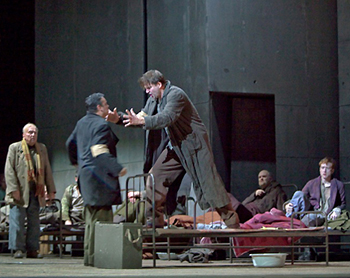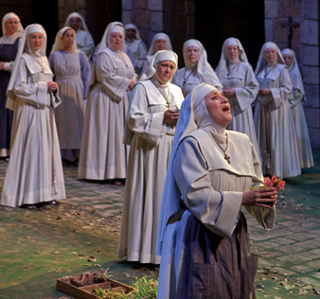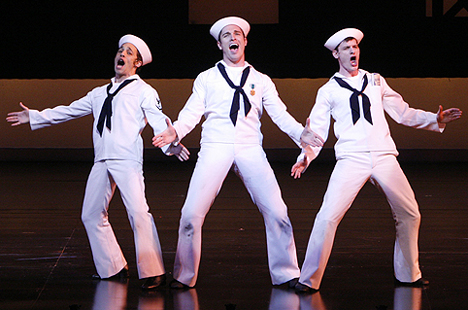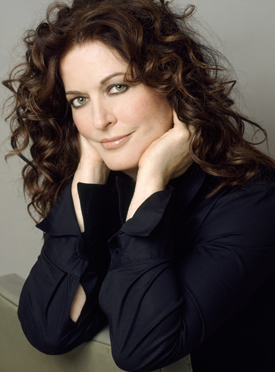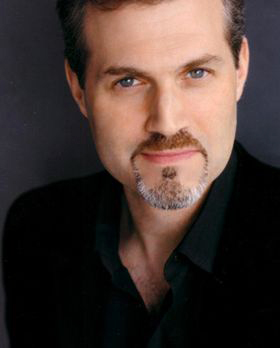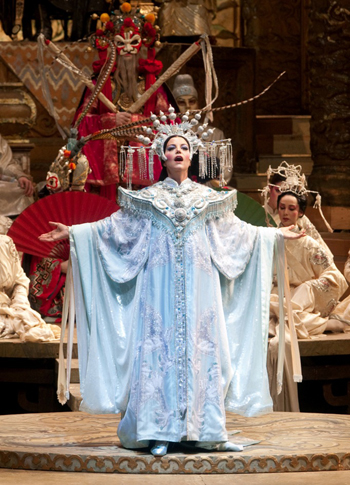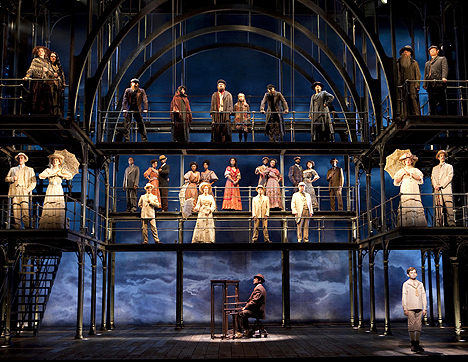
Many Thanks
Whew! The fall of 2009 has been an exceptionally active time on and off Broadway, with multiple shows opening each week, aside from all other kinds of special events. Of course, there have been some disappointments among the batch; but now that Thanksgiving Day is upon us, I thought this would be an excellent time to express my appreciation of various productions, artists, etc. that deserve all of our thanks. Carry on!
********************
The producers of Ragtime
Bravo to anyone who had anything to do with getting this superb revival, first seen at the Kennedy Center, to Broadway. I've always considered Ragtime to be one of the most beautiful musicals of the late 20th-century, but some people are regrettably immune to its glories and are turned off by its largely presentational style. Indeed, peppered among the deserved cheers for this revival have been a few hard-to-fathom critiques of the production and of the show itself. Please don't listen to the naysayers; Ragtime is gorgeous, and this brilliant staging by Marcia Milgrom Dodge is not to be missed by anyone who loves musical theater.
The director and company of Brighton Beach Memoirs
Some big mistakes may have been made in terms of marketing the very short-lived revival of this Neil Simon play (and its companion piece Broadway Bound, which never even opened), but the production itself was just as perfect as anyone could ask for. So here's a tear-stained "thank you very much" to director David Cromer and cast members Laurie Metcalf, Dennis Boutsikaris, Santino Fontana, Jessica Hecht, Josh Grisetti, Grace Bea Lawrence, Allan Miller, Noah Robbins, and Alexandra Socha. (Note: Both Fontana and Hecht have already been snapped up for the upcoming Broadway revival of Arthur Miller's A View From the Bridge that will star Liev Schreiber and Scarlet Johansson. Good for them!)
Broke-ology
All too often, the new plays that New York's not-for-profit theaters choose to produce are head-scratchers. (The Retributionists, anyone?) So it's both a reward and a relief when a worthy work by an up-and-coming playwright is mounted -- e.g., Broke-ology, the alternately hilarious and moving famiily drama by Nathan Louis Jackson that just ended its limited run at Lincoln Center's Mitzi E. Newhouse Theater. Bravo to Jackson, to director Thomas Kail, and to the entire company.
John Kander
The awesome versatility of this iconic Broadway composer was full demonstrated in a recent "Broadway Close-Up" concert at Merkin Hall in which such stars as Chita Rivera, Debra Monk, Karen Ziemba, and David Hyde Pierce performed only a tiny percentage of the songs that Kander and his late songwriting partner Fred Ebb wrote for such shows as Chicago, Cabaret, The Happy Time, Kiss of the Spider Woman, and Curtains. Here's hoping that the upcoming Vineyard Theatre production of Kander & Ebb's The Scottsboro Boys will be embraced by audiences, and that The Visit -- another of the team's final collaborations -- will also receive a major New York production sooner rather than later, with the amazing Chita starring as she did in productions in Chicago and D.C.
Henry Krieger
I was fortunate enough to speak with Mr. Krieger briefly during intermission of the new production of Dreamgirls that's raising the roof of the Apollo Theater in Harlem prior to beginning a national tour, so I was able to thank him personally for his phenomenal score for this beloved show. In collaboration with lyricist/book writer Tom Eyen and original director/choreographer Michael Bennett, both now deceased, Krieger created a dream of a musical that's more than strong enough to stand up against infelicities of staging -- such as the inability of Robert Longbottom, helmer of the new production, to direct actors. Bless you, Henry!
Theresa Rebeck, Justin Kirk, Mark-Paul Gosselaar, and Julie White
It's true that Rebeck's new play, The Understudy, presents a not entirely realistic view of the way theater productions and rehearsals work. It's also true that this is one of the flat-out funniest and most endearing new comedies I've seen in a long time, due both to Rebeck's writing and the stellar performances of Mark-Paul Gosselaar, a TV star making a very impressive New York stage debut; Justin Kirk, back on the boards where he belongs; and Julie White, brilliant but just a little bit over the top in The Little Dog Laughed, here giving a performance that's just as funny but better calibrated. The combined efforts of these artists, plus director Scott Ellis, have given us one of those relatively rare Roundabout Theatre Company productions that isn't seriously flawed and is well worth seeing.
Warren Carlyle
Whatever was wrong with the short-lived Broadway musical A Tale of Two Cities, it had nothing to do with the efforts of helmer Warren Carlyle. Happily, this talented fellow has recovered from that disappointment to give us two stellar shows within the space of a month: the grandish Broadway revival of Finian's Rainbow, which he both directed and choreographed, and the utterly delighful City Center Encores! presentation of Girl Crazy, expertly directed by Jerry Zaks and excitingly choreographed by Carlyle. Great job!
Jane Houdyshell and Dee Hoty
In the debacle that is the Roundabout Theatre Company's revival of Bye Bye Birdie, directed and choreographed by Robert Longbottom, almost all of the actors seem to be at sea without a life raft. Two major exceptions are Jane Houdyshell, who nails several big laughs as the overbearing mama-from-hell Mae Peterson; and Dee Hoty, who as Mrs. McAfee looks lovely as ever, retains her dignity, and is just about the only lead who manages to sing on pitch throughout the show. It ain't easy to come up smelling like a rose when an entire production is tanking around you, so these honored theater vets deserve an extra hearty round of applause.
Daniel Craig and Hugh Jackman
Need I do much more than invoke their names? Over and above their mesmerizing performances in A Steady Rain, Craig (in his Broadway debut!) and Jackman (returning after his personal triumph in The Boy From Oz) have raised many thousands of dollars for Broadway Cares/Equity Fights AIDS by practically selling the shirts off their backs in post-performance auctions. A friend of mine recently wondered, "When someone pays $5,000 for a sweaty T-shirt worn by one of those guys, what do you suppose they do with the thing when they get it home?" My response: I really don't care, as long as the money goes to such a great cause.
Michael McKean and Jon Michael Hill
Tracy Letts's Superior Donuts is an entertaining yet uneven play, certainly a far less satisfying achievement than his award-winning August: Osage County. But this half/sitcom, half/drama is sparked by the veteran McKean as the disillusioned, middle-aged proprietor of a donut shop and super-talented newcomer Hill as his brash, eager, brilliant young employee. It's always a treat to see the former doing his stuff on stage, and it's tremendously exciting to catch the latter in the early stages of what is sure to be a great career.
Jude Law in Hamlet
His performance may not be definitive (as if such a thing were possible), but Law certainly is the hottest Hamlet I've ever seen -- and it's clear that the audience agrees! This is the actor's first time on Broadway since he appeared in Indiscretions 14 years ago, prior to achieving film stardom. Let's hope it won't be anywhere near so long before we see him again.
The Royal Family
Not only is Manhattan Theatre Club's revival of this valentine to the theater wonderful in itself, it also warms the heart because it indicates that, following this show and last season's Accent on Youth, Manhattan Theatre Club is back on track after a series of major disappointments. Rosemary Harris, Jan Maxwell, Reg Rogers, and a dozen other terrific actors in an expertly produced revival of the classic comedy by George S. Kaufman and Edna Ferber, with absolutely gorgeous scenic design by John Lee Beatty and costumes by Catherine Zuber? Great stuff!
Love, Loss, and What I Wore
Sometimes, there's great beauty in utter simplicity. This show at the Westside Theatre -- written by Nora Ephron and Delia Ephron, based on the book by Ilene Beckerman -- consists of a rotating cast of well-known actresses sitting on stools and reading women's vivid reminiscences of how they were attired at key moments in their lives. When I attended, the cast included Tyne Daly, Katie Finneran, and Rosie O'Donnell in the finest acting performance I have ever seen her give.
The David Rubenstein Atrium at Lincoln Center
This beautiful new, multi-purpose space, located on Broadway between 62nd and 63rd streets, offers free live music every Thursday at 8:30pm, in addition to day-of discount tickets to Lincoln Center performances, a staffed information desk, restrooms, free Wi-Fi access, and a cafe overseen by Tom Colicchio, chef/owner of the Craft family of restaurants. Check out the two awesome "veritcal gardens," the floor-to-ceiling fountain, and the huge media wall, as well as the 97-foot felt wall art installation composed on 114 panels by noted Dutch textile artisan Cludy Jungstra. For more info, click here.
The Broadway Series at The Town Hall
Created, produced, and hosted by the indefatigable Scott Siegel, this series of concerts has become an essential part of New York City's cultural life. Its most recent presentation was a fabulous Broadway Unplugged concert highlighted by the thrilling, non-amplified performances of such folks as Daniel Reichard, William Michals, Bill Daugherty, Sarah Jane McMahon, Janet Metz, Emily Skinner, Marc Kudisch, and Jeffry Denman. More, please!
Bea Arthur and Marilyn Cooper
One of these ladies was world-famous as a TV star, in addition to her theater work; the other was best known to theatergoers. Both are irreplaceable, as memorial services held this fall -- Arthur's at the Majestic Theater, Cooper's at Sardi's -- reminded us. Dramatic actors are the ones who tend to win most of the awards and attention, but there must be a special place in heaven for those brilliant comedians who bring joy to our lives through the precious laughter they engender. Rest in peace, Bea and Marilyn -- and thank you from the bottom of our hearts.
